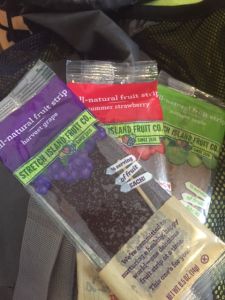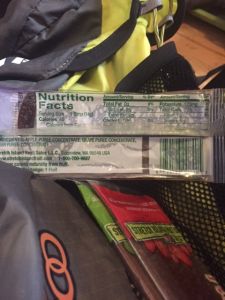Loving the BITE: Fruit Strip Fuel
 It’s no secret that I often shop outside the “sports nutrition” aisle when picking out training fuel. Even if you don’t have the time or want to go for full-on homemade fuel, there are real food options for you. One of my current favorites is fruit strips.
It’s no secret that I often shop outside the “sports nutrition” aisle when picking out training fuel. Even if you don’t have the time or want to go for full-on homemade fuel, there are real food options for you. One of my current favorites is fruit strips.
When I was growing up, they were not called “fruit strips.” They were called fruit roll-ups, and there was absolutely no fruit in them. They were cut into shapes, sometimes you ate them by the foot, and sometimes they were neon. Although this is nostalgic, that’s where the goodness ends. And, as responsible grown up who want to fuel our bodies well (wink), we can do better. And thankfully, some food manufacturers have decided to use real fruit in their fruit strips.
Nothing too deep or challenging this week. We’re going with fruit strips. Here’s how I use them, which ones I choose, and how they stack up to engineered, commercial training fuel options.
Recipe of the Week: Fruit Strip Fuel
Ingredients:
- 2 100% fruit strips (I like Stretch Island Fruit Co.)
- 1/12 tsp sea salt total, divided between both fruit strips (optional)
Directions:
- Find good quality 100% fruit strips. Should provide 25-30 gm carbs per 2 strips.
- If adding salt for sodium needs, first cut strip in half width-wise. Sprinkle with half of the salt (1/24 tsp – geesh!). Place cut half on top and press down to seal. Repeat on 2nd strip.
- Eat 1 serving per hour when riding (25-30 grams carbs).
Comments:
Let’s do a little comparison, shall we?
Nutrition:
The average gel has about 25-33 grams carbohydrates, 50-200 mg sodium, and little else. Some have some a bit of potassium, some have amino acids (but not enough to really be of benefit) and some have caffeine (this can of benefit). Some of them are engineered to contain a 2:1 ratio of glucose:fructose to improve absorption and metabolism of sugars each hour. This can also be a good thing.
not enough to really be of benefit) and some have caffeine (this can of benefit). Some of them are engineered to contain a 2:1 ratio of glucose:fructose to improve absorption and metabolism of sugars each hour. This can also be a good thing.
It takes 2 fruit strips to equal the amount of carbs in your average gel. Sounds fine to me since I love the apricot and strawberry. So, carbs can easily match up. These fruit strips have 120 mg (close to hourly nutrition goals), no amino acids, and no sodium (unless of course, you go ahead and add 1/12 tsp of salt, providing 200 mg). As far as carb make-up, apple/berry purees (the primary ingredients) are about 50/50 sucrose and fructose. Since sucrose is 50/50 glucose and fructose, these end up with a 1:3 glucose:fructose carbohydrate composition.
You can choose to care about this. Or not. If you follow the science that shows increased absorption and utilization of carbs with a 2:1 ratio, you may think twice. If you consider all the happy, healthy, and podium-topping athletes who choose real foods like bananas, rice, or other imperfect ratio foods, you may just opt for carbs that taste good and don’t make you want to hurl. If you’ve had issues with fructose based carbs in the past, skip this one. However, most issues result from engineered fuels with “fructose” ingredients…not real foods.
Taste:
This is a matter of preference, but for me it’s a no-brainer. Real fruit strips win. These are made only of fruit puree (we’re not even just talking solidified fruit juice, but actual fruit purees) and nothing else. They come in Raspberry, Strawberry, Apricot, Grape, Apple, and
Logistics:
Both are each to carry and very lightweight. To make the strips more compact, I recommend adding the salt and smashing them in half, and then putting them in a baggie, making them only 1-2 bites each. Both are sticky, but gels are definitely more of a sticky mess than most anything. I’ve got the jersey pocket stains to prove it.
Price:
My favorite gels are $1.10 each. I get these particular fruit strips at Costco for around $10 for 48 strips. So, each costs $0.21 and $0.42 for 2 (for the sake of comparison to 1 gel).
What’s your take? Do you use fruit strips? Are you ready to try ’em? How about the salt?
This week, if you’re tired of gels or your usual carbs and just want some variety, try salted fruit strips. They taste great, deliver the carbs, and provide real-food fuel you can look forward to.
Fuel Your Ride. Nourish Your Body.



Ah yes, I also remember calling it fruit leather! I haven’t had the ones from Trader Joes, but the Fruit Island brand can also be found at my regular grocer for about $.50 each. I like adding the salt because I recommend at least 400 mg sodium per hour, and most cyclists don’t get nearly this much (many of my clients alleviate cramps when we correct this). The 1/12 tsp will add about 200 mg sodium, so it’s remarkable. And yes, calcium is another electrolyte, and is a good idea on long rides of 3+ hours. The tums can also help if you suffer from any acid reflux on the bike. Thanks for your comment! Take care!
I haven’t used fruit strips in a long time, other than an occasional snack. When I was a kid we called them fruit leather and there was only healthy options from speciality stores, till those neon things came along that were available in any grocery store. It is nice to see that that opened the door for the healthy ones to move into mainstream stores. I didn’t know costco had them, I’ll have to check them out. I like the ones from Trader Joes. I didn’t know calorie wise they were close to gel packs, though it makes sense.
Not sure about the salt, but on some “long” rides I’ll take a couple Tums and eat them every hour to two hours for the calcium. That’s and electrolyte, right?